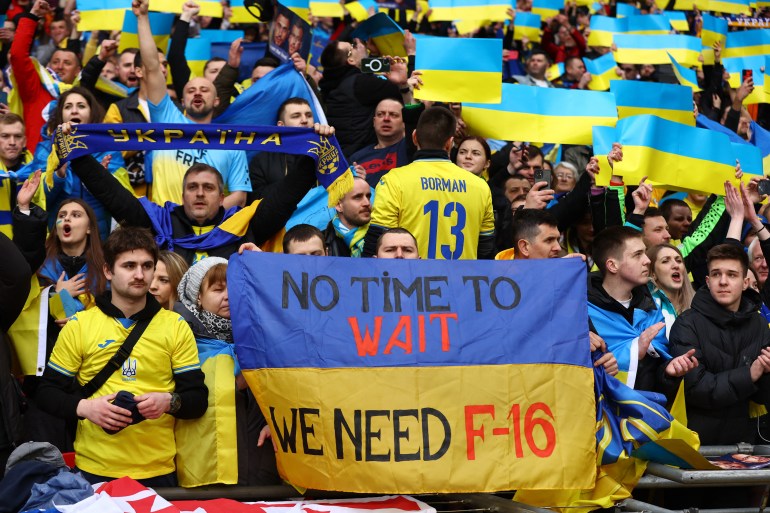Kyiv, Ukraine – The first US-made F-16 fighter jets have yet to appear in the sky over Ukraine, but there’s already a bounty on them.
Fores, a Russian company that produces equipment for oil drilling, said that it would pay 15 million rubles, or about $170,000, to the first Russian pilot who shoots down an F-16.
Russia will also rain supersonic ballistic missiles to destroy the F-16s on Ukrainian soil. Kyiv already plans to station some of them in other Eastern European nations such as Poland.
“Understandably, they will be hunted down,” Lieutenant General Ihor Romanenko, ex-deputy head of Ukraine’s general staff of armed forces, told Al Jazeera. “But we will serve them, hide them, equip and use them.”
The first dozen of F-16s are expected to arrive in Ukraine within weeks as their pilots complete their training.
The single-engine aircraft, also known as the Fighting Falcon or the Viper, has been featured in countless Hollywood action movies and video games.
It took to the sky in 1974 and was developed after the war in Vietnam, where Soviet MiGs overwhelmed heavier and slower US fighter jets.
Produced by Lockheed Martin, the F-16 is one of the world’s most widely-used fighter jets procured by two dozen nations worldwide.
But 50 years after its inception and with the emergence of new generations of fighter jets, it is unlikely to become a game-changer in the Russia-Ukraine war, observers said.
“They say F-16s are manna from heaven. Far from it,” Romanenko quipped.
The engine’s air intake is located too low and can swallow pebbles from potholed Ukrainian airstrips – that can also be dangerous to the plane’s small wheels.
A much bigger problem is the range of missiles the West would supply for them.
Like a Lego toy, an F-16 can carry various missiles or bombs, but the planes Ukraine is getting come with very small add-ons.
“We’re on the hook with the weaponry they will give us,” Romanenko said.
The missiles will most likely have a range of 120km (75 miles) – while Russian missiles can fly up to 300km (186miles).
“You wriggle any way you can,” Romanenko said. “And we will indeed have to wriggle.”

The training for Ukrainian pilots lasted for six months – a short period to master the basics of flying, dodging enemy fire and engaging enemy planes.
Ukrainian pilots also needed English training – and had to re-adapt their habits of flying Soviet-produced fighter jets that were designed to counter F-16s and their F-15 siblings – but were not modelled on them.
Dozens more Ukrainian pilots will undergo similar training.
“The training will be extremely basic, which is also not a plus,” Mykhailo Zhirokhov, a military expert based in the northern Ukrainian city of Chernihiv, told Al Jazeera.
Therefore, the F-16s will be used “exclusively” as carriers of high-precision weapons, he said.
These days, the Ukrainian Air Force has US-made GBU precision-guided bombs that can glide for about 100km (62 miles) to their targets.
They also use Joint Direct Attack Munition kits that turn average “dumb” bombs into precision-guided munitions, and also received French-made AASM guided bombs, he said.
The F-16s will intercept Russian cruise missiles and Herans, modified Shaheed kamikaze drones developed in Iran, he said.
And as Russian missiles can potentially reach any Ukrainian airfield modified for F-16s, Kyiv may use them only as “jump airfields” for refuelling, Zhrokhov said.
Ukraine’s top brass hopes to get AIM-120 air-to-air missiles that could put an end to Russia’s biggest battlefield advantage.
In the past year, Russian planes didn’t have to fly over the actual Ukrainian positions as their heavy KAB bombs can glide for dozens of kilometres to precisely destroy the most fortified buildings.
The KABs have become a “miracle weapon that brings results and practically has no countermeasures,” Deep State, a Telegram channel with links to the Ukrainian military, wrote in March.
The KABs secured the widely-publicised takeover of Avdiivka and several more eastern Ukrainian towns.

Only one or two F-16s will be stationed on Ukrainian soil to “shoo away” Russian aircraft carrying the KABs, a German military analyst said.
“F-16s are too precious a gift, and too few are provided [to Ukraine] to risk them,” Nikolay Mitrokhin of Germany’s Bremen University told Al Jazeera.
They are not likely to be involved in direct fights with Russian fighter jets, and their duels will be limited to “not very effective” missile strikes, he said.
The F-16s will also strike surface targets – but only from distances that rule out Russia’s use of S-300 and S-400 air defence complexes, he said.
The Netherlands, Belgium, Denmark and Norway pledged to supply a total of 85 F-16s by 2028 as they receive far more advanced F-35 fighter jets from Washington.
It’s enough for four squadrons – but is far from the 120 aircraft Ukrainian President Volodymyr Zelenskyy asked the West for to counter the 300 Russian planes.
‘Twice as old as their pilots’
The Ukrainian air force has been neglected and underfunded for decades.
After the 1991 Soviet collapse, Kyiv gave away its fleet of Soviet-era bombers to Moscow.
A half of Russia’s 16 Tu-160 bombers that can carry 45 tonnes of bombs or a dozen missiles used to belong to Kyiv – and were “transferred” along with hundreds of missiles in the late 1990s as payment for Moscow’s natural gas.
The “youngest” Ukrainian fighter jet is a Su-27 made in 1991 – and other aircraft are often “twice as old as their pilots,” Ukrainian Air Force spokesman Yuri Ihnat said in televised remarks in 2023.
Kyiv has about 50 MiGs-29 and two dozen Sukhoi 27 fighter jets whose notoriously flawed radars have short detection range and can be easily jammed by Russians.
Moscow uses newer and better equipped MiGs and Sukhois, and Ukraine destroyed at least a dozen on airfields in occupied regions or mainland Russia.
Kyiv has lost at least 22 of its MiGs, but Germany, Poland and Slovakia donated 27 similar planes that mostly became a source of spare parts.
And while Western nations such as France and Sweden offered their advanced fighter jets, Washington pushed Kyiv to accept F-16s to secure their use in Ukraine for decades to come, experts say.
“This is defence of American military industrial complex and a matter of geopolitical influence,” Kyiv-based analyst Aleksey Kushch told Al Jazeera.
Read More: World News | Entertainment News | Celeb News
Aljazera







